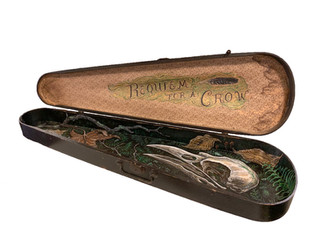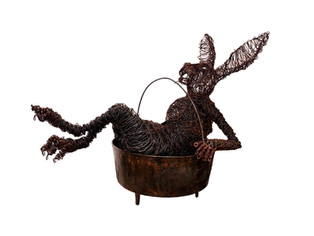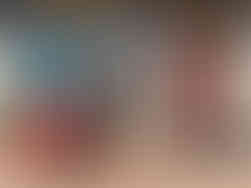Bunnies and Bogies: Josh Cote Exhibition Recap
- Kentuck

- Mar 10, 2020
- 4 min read
Updated: Jan 21
Pop quiz: What has two eyes, two ears, and takes 1.5 miles of wire to create?
I'll bet your first answer to that question wasn't "colossal rabbit sculptures."

"My art and sculpture has been a dichotomy of tenderness and intensity—light and dark, soft and sharp. Bunnies and Bogies envelops this spectrum of my work—rainbow bunny fantasies and shadowy devil nightmares."
It seems that Josh Cote was born into this world clutching "Bunny," his favorite stuffed rabbit. Or, if he weren't, he might as well have been. Josh's earliest childhood memories include jumping through mud puddles and treasure hunting in the landfill with Bunny. During one of those trips to the landfill, he found another stuffed rabbit, named Peter, who became as close a companion as Bunny. On one fateful, traumatic day when Josh's family was moving, Peter was accidentally left behind! This pivotal event is just one memory from Josh's childhood that heavily directs his work.
Josh grew up in the '70s with two hippie artist parents and a devout Christian grandmother. When Josh was a kid, art festivals were just beginning to pop up all over the country. Josh, his parents, and two white German shepherds piled into their Land Rover and traveled to art festivals all over the east coast. Both worlds--the not-so-religious hippies and the devout Christian grandmother--have had profound impacts on Josh's discordant ideology today.
"I like a world that is peculiar...with darkness and predators and fuzzy bunnies bouncing about."
In "Bunnies and Bogies," Josh's wire sculptures are predominantly rabbits, as the exhibition title suggests, but there are several other animals featured, including cats, crows, an owl, and a pig. Each animal seems to come pre-loaded with its own personality—the larger-than-life anthropomorphic bunnies are often portrayed doing activities seemingly unfit for rabbits. One rabbit is driving a car, one is swinging from the ceiling, and one is splayed out on the floor with one arm behind its head—poking fun at the "reclining nude" trope in western art history.

Though the viewer has surely not seen anything quite like Josh Cote's artwork, many of the pieces include antique found objects that evoke a sense of child-like nostalgia. Bunnies playing with bicycles, pedal cars, and tricycles are scattered around the gallery and are admired by fans both young and old. Ever since his childhood stuffed rabbit, Peter, was left behind in a move, Josh honors his friend by bringing him to life in the medium of wire. Many rabbits have come and gone from his life, but the memory of Peter reminds him—and in turn, the viewer—to never grow up.

Josh's exhibition fearlessly tackles the concept of duality—the playful bouncing bunnies seem to peacefully coexist with concepts viewers would typically associate with the darkest parts of human existence. Several sculptures of the devil leer at viewers: one is trapped in a birdcage with disassembled baby doll limbs and another is riding a pig. Other references to humans' collective fears are represented by fire and skeletons in a large, wall-sized collage called "Sunday Drive."

At first, viewers may be a bit unsettled by the nightmarish reminders of human frailty. However, if the viewer looks closer—past the skeletons and devils and fire—the viewer may begin to notice the humor that unites the entirety of the exhibition. The same humor and personality intrinsic to the bouncing bunnies is found equally in the religious iconography of titles like "Deviled Ham," "Sunday Drive," and "Keep Your Devil Caged." In "Sunday Drive," a closer look may reveal some jokes hidden in the construction of the collage.
Above: Details of "Sunday Drive" by Josh Cote
Josh makes it clear that he feels equally comfortable with both sides of his ideology, and in fact, lives harmoniously in the middle. Viewers will notice a number of crows in the exhibition, second only to the bunnies. Crows are a visual representation of Josh's spiritual guide; perhaps helping him exist in the middle of his seemingly contradictory artwork.
"Crows to me are not just birds, but are spiritual guides, shamans, or shape shifters," Josh explained. "I love the rich folklore surrounding corvids. Some cultures believed we become crows or ravens in the afterlife. I think that would be my dream—there are so many stories of crafty crows and ravens solving human problems."
At face value, some of Josh's work seems dark, but that darkness never overtakes the humor that bonds the exhibition. Much like light cannot exist without darkness, Josh's world cannot exist without whimsical bouncing bunnies and devilish nightmares.

Available works
To purchase a piece from Bunnies and Bogies, please call (205)-758-1257 before May 2, 2020. More photos and videos available upon request.
Row 1: "Sunday Drive," "Screaming Crow," "The Circus is Dead"
Row 2: "The Intinhareant Travelhare," "Space Shark," "Reclining Nude"
Row 3: "Keep Your Devil Caged," "Return to Paradise Lost," "Krampus Music"
Row 4: "Mobile Bunny," "Son of Dog," "I'm All Ears"
Row 5: "Walking Crow," "Deviled Ham," "Hungry Cat"
Row 6: "Archer Deathcart," "Requiem for a Crow," "Night Owl"
Row 7: "Crow Calling Red Phone," "Black Cat," "High Flying Hare"
Row 8: "Silver Short Hare," "Wild Hare," "Stew Boat"
Purchased
Row 1: "Spring Hare," "Wish You Were Hare," "Driving with the Wind in my Hare"
Row 2: "Hari Hare," "Crow Calling," "Catastrophe"
Row 3: "Walking Crow"

"My house was solid white and it just looked like a banal, blank canvas to me. I wanted my house to reflect my personality and give this Appalachian holler I live in a dissonant splash of color. A home for my whimsical bunnies! There are eleven different colors: 5 shades of purple, greens, blues, reds, yellow, and orange. The inside is jam-packed with folk art I have collected from other artists, too."











































































